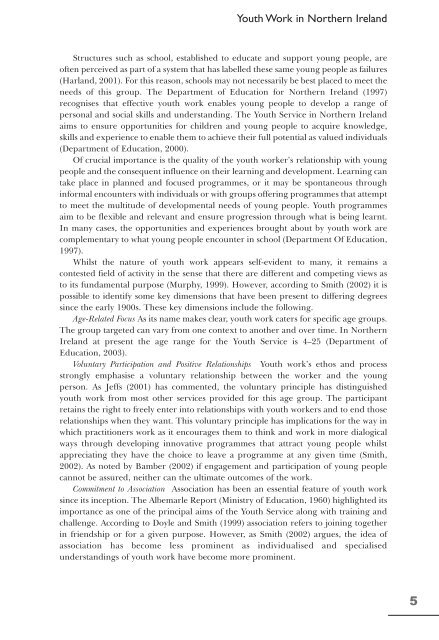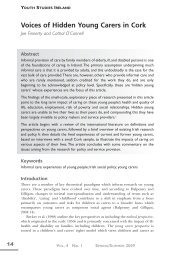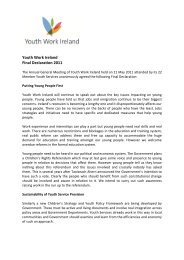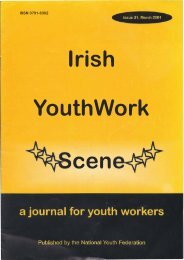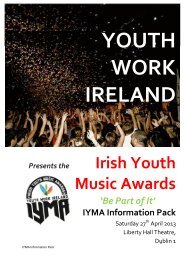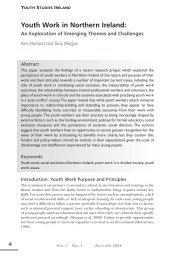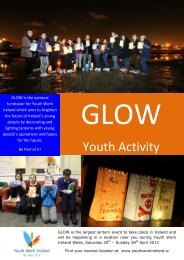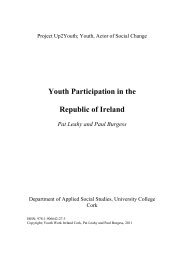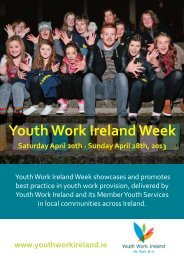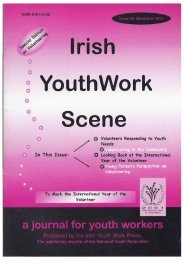Download full edition - Youth Work Ireland
Download full edition - Youth Work Ireland
Download full edition - Youth Work Ireland
You also want an ePaper? Increase the reach of your titles
YUMPU automatically turns print PDFs into web optimized ePapers that Google loves.
<strong>Youth</strong> <strong>Work</strong> in Northern <strong>Ireland</strong>Structures such as school, established to educate and support young people, areoften perceived as part of a system that has labelled these same young people as failures(Harland, 2001). For this reason, schools may not necessarily be best placed to meet theneeds of this group. The Department of Education for Northern <strong>Ireland</strong> (1997)recognises that effective youth work enables young people to develop a range ofpersonal and social skills and understanding. The <strong>Youth</strong> Service in Northern <strong>Ireland</strong>aims to ensure opportunities for children and young people to acquire knowledge,skills and experience to enable them to achieve their <strong>full</strong> potential as valued individuals(Department of Education, 2000).Of crucial importance is the quality of the youth worker’s relationship with youngpeople and the consequent influence on their learning and development. Learning cantake place in planned and focused programmes, or it may be spontaneous throughinformal encounters with individuals or with groups offering programmes that attemptto meet the multitude of developmental needs of young people. <strong>Youth</strong> programmesaim to be flexible and relevant and ensure progression through what is being learnt.In many cases, the opportunities and experiences brought about by youth work arecomplementary to what young people encounter in school (Department Of Education,1997).Whilst the nature of youth work appears self-evident to many, it remains acontested field of activity in the sense that there are different and competing views asto its fundamental purpose (Murphy, 1999). However, according to Smith (2002) it ispossible to identify some key dimensions that have been present to differing degreessince the early 1900s. These key dimensions include the following.Age-Related Focus As its name makes clear, youth work caters for specific age groups.The group targeted can vary from one context to another and over time. In Northern<strong>Ireland</strong> at present the age range for the <strong>Youth</strong> Service is 4–25 (Department ofEducation, 2003).Voluntary Participation and Positive Relationships <strong>Youth</strong> work’s ethos and processstrongly emphasise a voluntary relationship between the worker and the youngperson. As Jeffs (2001) has commented, the voluntary principle has distinguishedyouth work from most other services provided for this age group. The participantretains the right to freely enter into relationships with youth workers and to end thoserelationships when they want. This voluntary principle has implications for the way inwhich practitioners work as it encourages them to think and work in more dialogicalways through developing innovative programmes that attract young people whilstappreciating they have the choice to leave a programme at any given time (Smith,2002). As noted by Bamber (2002) if engagement and participation of young peoplecannot be assured, neither can the ultimate outcomes of the work.Commitment to Association Association has been an essential feature of youth worksince its inception. The Albemarle Report (Ministry of Education, 1960) highlighted itsimportance as one of the principal aims of the <strong>Youth</strong> Service along with training andchallenge. According to Doyle and Smith (1999) association refers to joining togetherin friendship or for a given purpose. However, as Smith (2002) argues, the idea ofassociation has become less prominent as individualised and specialisedunderstandings of youth work have become more prominent.5


